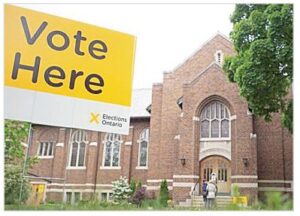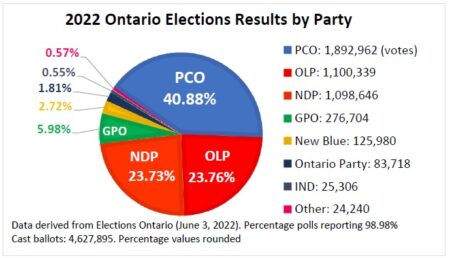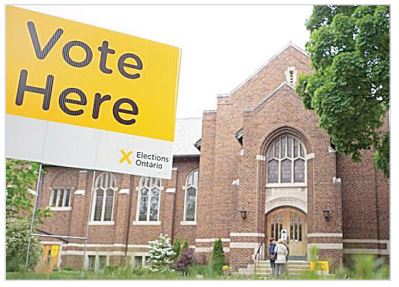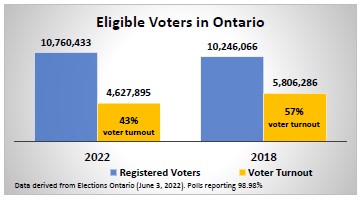The election numbers tell a worrying story

TORONTO – The results were barely tabulated and a horde of “political scientists”, commentators and Party lobbyists emerged from nowhere to advance their interpretation of the outcome of Election Ontario, 2022.There was a sense of revisionism in their analyses, an attempt to “interpret for the great unwashed” what their votes for the PC really meant.
With 98.98% of the ballots counted, they seemed to still be hanging on to their view of what they wanted to have happened – and or what did happen. Liberals and NDP sympathizers claimed that the voters had clearly established the character of the province as “progressive”.
One supposes that if names are an indication of character, then they are correct. The Progressive Conservatives won the right to form a second successive majority government, having succeeded in securing 83 out of 124 available seats in the Legislature.
There were a total of twenty six – yes 26 – “parties” listed on the ballots in various parts of the electoral map of Ontario. None of them, other than Doug Ford’s PCs, sported the name “progressive”. None identified themselves as trendy wokists, cancel culture activists, or any other special interest groups which have seized control of the platforms for public discourse.
It is tempting to speculate that the general public will have nothing to do with any group that will not or cannot openly face the litmus test of electorate. They camouflage themselves within various parties. The whining began immediately: Liberals and NDP “need to unite” under one umbrella to beat the Conservative agenda.
They should give their head a shake. That was arguably the strategy advanced by former Liberal leader Wynne. She crashed the party. The NDP under Horwath should have been able to capture the residue in 2018, instead, even in what was clearly a “change election” voters opted for the Conservatives.
Both failed to inspire the citizenry with their rhetoric or platforms. At the time, only 57% of the voting public felt the urge to cast a ballot.
Tactical positioning and slogans are a poor substitute for substantive issues and institutional infrastructure.
So, when one compares the results of 2018 to those of 2022, it should come as no surprise that only 43.03% of eligible voters cast a ballot (Elections Ontario results based on 98.98% of ballots counted). The PCs receive about 40.88% of that.
Think about this: 17.6% of the electorate decided who should be our Premier and who should name our Executive Council, the Cabinet in Ontario. A mere 33% of the voters in the Premier’s constituency bothered to vote.
That is not the fault of the Premier.





